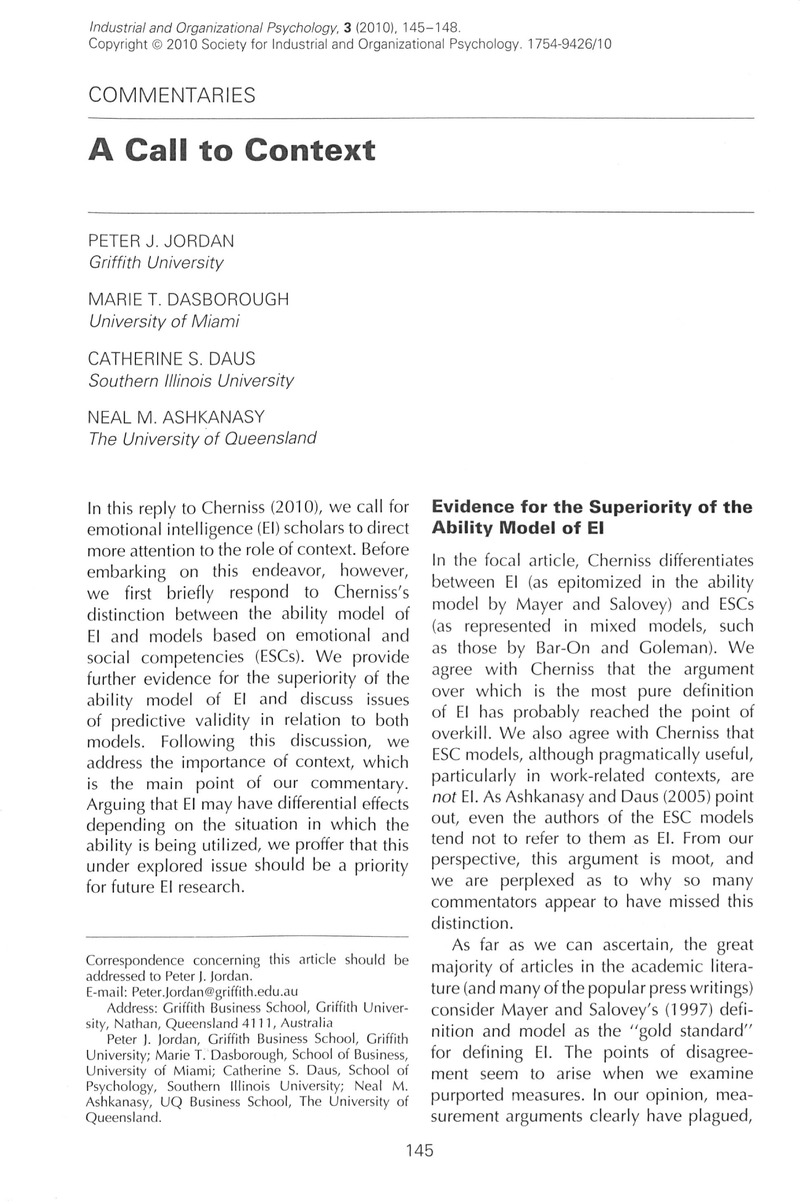Crossref Citations
This article has been cited by the following publications. This list is generated based on data provided by Crossref.
Cherniss, Cary
2010.
Emotional Intelligence: New Insights and Further Clarifications.
Industrial and Organizational Psychology,
Vol. 3,
Issue. 2,
p.
183.
Jordan, Peter J.
and
Troth, Ashlea
2011.
Emotional intelligence and leader member exchange.
Leadership & Organization Development Journal,
Vol. 32,
Issue. 3,
p.
260.
O'Boyle, Ernest H.
Humphrey, Ronald H.
Pollack, Jeffrey M.
Hawver, Thomas H.
and
Story, Paul A.
2011.
The relation between emotional intelligence and job performance: A meta‐analysis.
Journal of Organizational Behavior,
Vol. 32,
Issue. 5,
p.
788.
Lindebaum, Dirk
and
Cartwright, Susan
2011.
Leadership effectiveness: the costs and benefits of being emotionally intelligent.
Leadership & Organization Development Journal,
Vol. 32,
Issue. 3,
p.
281.
Smollan, Roy
and
Parry, Ken
2011.
Follower perceptions of the emotional intelligence of change leaders: A qualitative study.
Leadership,
Vol. 7,
Issue. 4,
p.
435.
Walter, Frank
Cole, Michael S.
and
Humphrey, Ronald H.
2011.
Emotional Intelligence: Sine Qua Non of Leadership or Folderol?.
Academy of Management Perspectives,
Vol. 25,
Issue. 1,
p.
45.
Winkel, Doan E.
Wyland, Rebecca L.
Shaffer, Margaret A.
and
Clason, Patricia
2011.
A new perspective on psychological resources: Unanticipated consequences of impulsivity and emotional intelligence.
Journal of Occupational and Organizational Psychology,
Vol. 84,
Issue. 1,
p.
78.
Fiori, Marina
and
Antonakis, John
2012.
Selective attention to emotional stimuli: What IQ and openness do, and emotional intelligence does not.
Intelligence,
Vol. 40,
Issue. 3,
p.
245.
Lindebaum, Dirk
and
Jordan, Peter J.
2012.
Relevant but exaggerated: the effects of emotional intelligence on project manager performance in construction.
Construction Management and Economics,
Vol. 30,
Issue. 7,
p.
575.
Lindebaum, Dirk
and
Cassell, Catherine
2012.
A Contradiction in Terms? Making Sense of Emotional Intelligence in a Construction Management Environment.
British Journal of Management,
Vol. 23,
Issue. 1,
p.
65.
Lindebaum, Dirk
2012.
I Rebel—Therefore We Exist.
Journal of Management Inquiry,
Vol. 21,
Issue. 3,
p.
262.
Walter, Frank
Cole, Michael S.
der Vegt, Gerben S. van
Rubin, Robert S.
and
Bommer, William H.
2012.
Emotion recognition and emergent leadership: Unraveling mediating mechanisms and boundary conditions.
The Leadership Quarterly,
Vol. 23,
Issue. 5,
p.
977.
Daus, Catherine S.
Dasborough, Marie T.
Jordan, Peter J.
and
Ashkanasy, Neal M.
2012.
Experiencing and Managing Emotions in the Workplace.
Vol. 8,
Issue. ,
p.
375.
Emery, Cécile
2012.
Uncovering the role of emotional abilities in leadership emergence. A longitudinal analysis of leadership networks.
Social Networks,
Vol. 34,
Issue. 4,
p.
429.
Lindebaum, Dirk
2013.
Does emotional intelligence moderate the relationship between mental health and job performance? An exploratory study.
European Management Journal,
Vol. 31,
Issue. 6,
p.
538.
Giorgi, Gabriele
2013.
Organizational emotional intelligence: development of a model.
International Journal of Organizational Analysis,
Vol. 21,
Issue. 1,
p.
4.
Iliescu, Dragos
Ilie, Alexandra
Ispas, Dan
and
Ion, Andrei
2013.
Examining the Psychometric Properties of the Mayer-Salovey- Caruso Emotional Intelligence Test.
European Journal of Psychological Assessment,
Vol. 29,
Issue. 2,
p.
121.
Peus, Claudia
Braun, Susanne
and
Frey, Dieter
2013.
Situation-based measurement of the full range of leadership model — Development and validation of a situational judgment test.
The Leadership Quarterly,
Vol. 24,
Issue. 5,
p.
777.
Braun, Susanne
Peus, Claudia
Weisweiler, Silke
and
Frey, Dieter
2013.
Transformational leadership, job satisfaction, and team performance: A multilevel mediation model of trust.
The Leadership Quarterly,
Vol. 24,
Issue. 1,
p.
270.
Lindebaum, Dirk
and
Jordan, Peter J
2014.
When it can be good to feel bad and bad to feel good: Exploring asymmetries in workplace emotional outcomes.
Human Relations,
Vol. 67,
Issue. 9,
p.
1037.



